| Click On Image For Full Size | Size | Image Description | Source | ||||||||||||||||||||||||||||||||||||||||||||||||||||||||||||||||||||||||||||
|---|---|---|---|---|---|---|---|---|---|---|---|---|---|---|---|---|---|---|---|---|---|---|---|---|---|---|---|---|---|---|---|---|---|---|---|---|---|---|---|---|---|---|---|---|---|---|---|---|---|---|---|---|---|---|---|---|---|---|---|---|---|---|---|---|---|---|---|---|---|---|---|---|---|---|---|---|---|---|---|
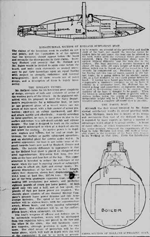 |
1.26k | SUBMARINE BOATS TO FIRE TORPEDOES UNDER WATER. THE NAVY DEPARTMENT IS TESTING THE WORK OF CAPTAIN NEMO. | Image and text provided by Library of Congress, Washington, DC. Photo & text by New-York Tribune. (New York [N.Y.] 1866-1924, 13 August 1893, Image 8, courtesy of chroniclingamerica.loc.gov. | ||||||||||||||||||||||||||||||||||||||||||||||||||||||||||||||||||||||||||||
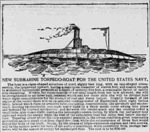 |
644k | NEW SUBMARINE TORPEDO-BOAT FOR THE UNITED STATES NAVY The boat is a cigar shaped structure of steel, eighty feet long, with an egg shaped cross section, the larger upward, having a maximum diameter of eleven feet, and stanch enough to withstand hydrostatic pressure at a depth of seventy-five feet, a reasonable factor of safety still remaining. Within, for three-fourths of her total length from her bow aft-ward. She will be strengthened by an inner hull, between which and her outer skin she will be divided into water-tight compartments for the storage of fuel and water ballast, slightly forward of the center of the vessel there will be an armored conning-tower cf Harveyized steel eight inches thick, behind which rises an armored tube containing, concentrically, the air shaft and smokestack, housing hydraulically and made water tight by a thick metal cover swung into place and fastened by internal mechanism: and between tho smoke stack and the conning-tower a small tube, also water-tight, carries the telescopic camera-lucida by which the navigator may sight and watch the enemy while the rest of the submarine boat lies three feet below the surface. Tapering armor about the only exposed position in the awash condition gives reasonable protection against small shot from rapid fire guns, while the submergence of three feet would shield the body of the craft. Steam by the means of triple expansion engines and twin screws will be the motive power for both of the surface conditions, while electricity from storage batteries will be the source of energy for submerged runs. The cost is to be $150,000. | Image and text provided by Kansas State Historical Society; Topeka, KS. Photo & text by The Iola Register. (Iola, Kan.) 1875-1902, 19 April 1895, Image 7, courtesy of chroniclingamerica.loc.gov.
|
 985k |
THE HOLLAND (SS-01) SUBMARINE BOAT RAMMING THE ENEMY UNDER WATER. | Image and text provided by University of Nebraska-Lincoln Libraries, Lincoln, NB. | Photo & text by Omaha Daily Bee. (Omaha [Neb.] 187?-1922, 08 March 1896, Image 13, courtesy of chroniclingamerica.loc.gov.
|
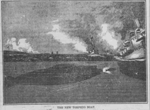 543k |
THE NEW SUBMARINE WONDER FOR OUR NAVY | Image and text provided by University of North Texas; Denton, TX. |
Photo & text by The Bryan Daily Eagle. (Bryan, Tex.) 1895-1898, 07 November 1896, Image 2, courtesy of chroniclingamerica.loc.gov. 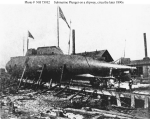 96k |
Submarine Plunger on a slipway circa the late 1890s, possibly while under construction at the Columbian Iron Works, Baltimore, Maryland.
Plunger was built under an 1895 Navy contract with the Holland Torpedo Boat Company but was not accepted for Naval service.
Note her triple propeller shafts.
This halftone reproduction was published in the "Journal of the American Society of Naval Engineers", May 1938.
|
Courtesy of John C. Reilly, Jr.
USN photo # NH 73932, from the collection of the U.S. Naval Historical Center.
|
|
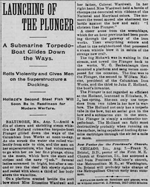 3.22k |
LAUNCHING OF THE PLUNGER | A Submarine Torpedo-Boat Glides Down the Ways. Rolls Violently and Gives Men on the Superstructure a Ducking. Holland's Second Steel Fish Will Soon Be in Readiness for Modern Warfare. Image and text provided by University of California, Riverside. | Photo & text by The San Francisco Call. (San Francisco [Calif.]) 1895-1913, 08 August 1897, Image 3, courtesy of chroniclingamerica.loc.gov.  183k |
Plunger, constructed under an 1895 contract with the Holland Torpedo Boat Company, this steam-powered submarine was not accepted for Naval service.
| Photograph from the Bureau of Ships Collection in the U.S. National Archives. USN photo # 19-N-11812, from the collection of the U.S. Naval Historical Center.
|
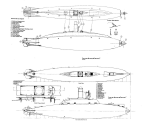 436k |
The U.S. Navy's first Plunger, as designed (top) and as completed (bottom) shows Holland's trademark centerline propeller on the hull axis, to drive the submarine along the line of the hull (which would be angled up or down by the stern planes). A pair of more conventional located propellers and a pair of vertical thrusters (bow and stern) were added. The camera lucida was an abortive periscope. | Photo & text courtesy of U.S. Submarines Through 1945, An Illustrated Design History by Norman Friedman. Naval Institute Press.
|
|
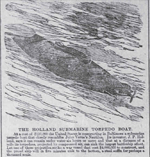 448k |
THE HOLLAND (SS-01) SUBMARINE TORPEDO BOAT | At a cost of $150,000 the United States is constructing in Baltimore a submarine torpedo boat that closely resembles Jules Verne's Nautilus. Its inventor, J. P. Holland says it can remain under water six hours or more and that at a distance of a mile its torpedoes, projected by compressed air, can sink the largest battleship afloat. Let one of these projectile strike a war vessel that cost S4,000,000 to construct, and the proud ship will in five minutes sink to the bottom, a steel coffin for a thousand souls. Image and text provided by University of Hawaii at Manoa; Honolulu, HI. | Photo & text by The Hawaiian Gazette. (Honolulu [Oahu, Hawaii] 1865-1918, 02 March 1897, Image 9, courtesy of chroniclingamerica.loc.gov. 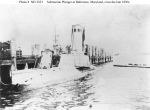 59k |
Submarine Plunger at the Columbian Iron Works, Baltimore, Maryland, circa the late 1890s, probably at the time of her completion.
Plunger was built under Navy contract with the Holland Torpedo Boat Company and ran dock trials, but never submerged. Not accepted for Naval service, she was retained by the contractor and junked in 1917.
Note the tall smokestack of this steam-powered submarine. |
Donation of Frank T. Cable, 1934. USN photo # NH 3033, from the collection of the U.S. Naval Historical Center. |
|
 1.12k |
SUBMARINE PLUNGER AFLOAT | Side and front views. The Plunger is just like the Holland (SS-01) boat, except that she is larger. Image and text provided by State Historical Society of Missouri; Columbia, MO. | Photo & text by Kansas City Journal. (Kansas City, Mo.) 1897-1928, 06 March 1898, Image 18, courtesy of chroniclingamerica.loc.gov. 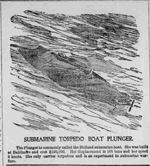 617k |
SUBMARINE TORPEDO BOAT PLUNGER. | The Plunger is commonly called the Holland submarine boat. She was built at Baltimore and cost $150,000. Her displacement is 108 tons and her speed 8 knots. She only carries torpedoes and is an experiment in submarine warfare. Image and text provided by University of Tennessee. |
Photo & text by The Maryville Times. (Maryville, Tenn.) 1884-1944, 26 March 1898, Image 4, courtesy of chroniclingamerica.loc.gov.
|
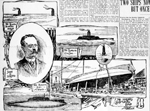 1.18k |
WHY HIS BOAT WAS IGNORED | Holland, the Inventor of the Submarine Wonder, Gives His Views on the Neglect of the Government to Utilize His Craft in the Present War. Image and text provided by Montana Historical Society; Helena, MT. |
Photo & text by The Anaconda Standard. (Anaconda, Mont.) 1889-1970, 07 August 1898, Morning, Image 18, courtesy of chroniclingamerica.loc.gov.
|
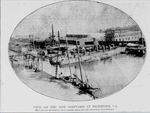 1.25k |
VIEW OF THE NEW SHIPYARD AT RICHMOND VA. | Showing two destroyers, three torpedo boats and the submarine boat Plunger. Image and text provided by Library of Congress, Washington, DC. | Photo & text by New-York Tribune. (New York [N.Y.]) 1866-1924, 30 December 1900, Image 26, courtesy of chroniclingamerica.loc.gov. 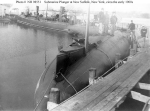 84k |
Submarine Plunger at the Electric Boat Company/Holland Torpedo Boat Company facility, New Suffolk, Long Island, New York, circa the early 1900s.
Winslow (TB-05) is in the background.
|
Photo i.d. courtesy of David Johnston |
Photo courtesy of the Submarine Force Library and Museum, Groton, Connecticut, 1989. USN photo # NH 98551, from the collection of the U.S. Naval Historical Center. 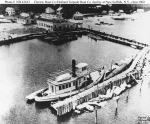 139k |
At the Submarine Electric Boat Company/Holland Torpedo Boat Company facility, New Suffolk, Long Island, New York:
Tender Kelpie, the original Plunger (of 1895) and several new submarines in the facility basin, circa 1902.
|
Courtesy of the Whitaker Collection, Southold Library, Southold, Long Island, N.Y., 1957. USN photo # NH 42623, from the collection of the U.S. Naval Historical Center.
|
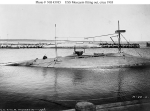 101k |
Moccasin (A-4) fitting out at the Electric Boat Company/Holland Torpedo Boat Company facility, New Suffolk, Long Island, New York, circa 1903. The incomplete submarine Plunger (of 1895) is in the background.
|
U.S. Naval Historical Center Photograph # NH 45935.
|
| ||||||||||||||||||||||||
Crew Contact And Reunion Information
Not Applicable to this Vessel
Additional Resources and Web Sites of Interest
WORLD SUBMARINE HISTORY TIMELINE 1580-2000
| Back To The Main Photo Index | Back To the Submarine Index |
|
Problems and site related matters, E-mail Webmaster |
|
This page is created and maintained by Michael Mohl NavSource History.All Pages © 1996 - 2023,NavSource History. All rights reserved. |